Overwatered Tomato Plant Signs & What to Do Next
Author: Jen Worst | Editor: Omar Alonso
Review & Research: Jen Worst & Chris Miller
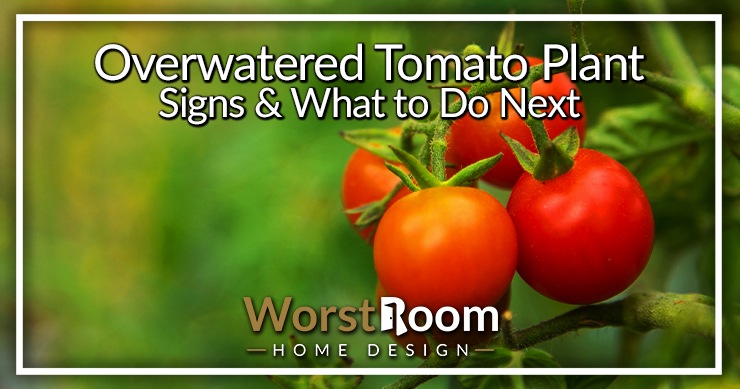
Tomato plants are the pride and joy of many gardeners, but overwatering these popular veggies can lead to a host of problems. Overwatered tomato plants may exhibit wilted leaves, yellowing stems, and even root rot, making it essential for gardeners to know how to identify and address this issue.
In this blog post, we will guide you through the signs of overwatering in tomato plants, provide helpful tips on how to save your beloved green friends from drowning in excess water, and offer preventative measures ensuring that your tomatoes thrive throughout their growing season.
How to Identify Signs of Overwatering Tomato Plants
Can you overwater tomato plants? You absolutely can. Overwatering in tomato plants can be identified through drooping or wilting plants, leaf spots and discoloration, foul odor or crusty soil.
Drooping or Wilting Plants
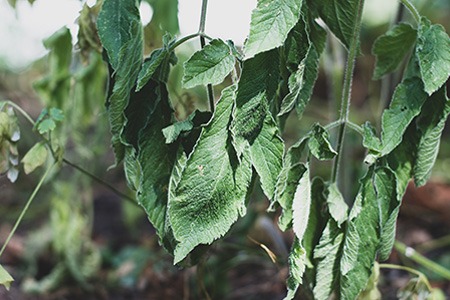
Overwatering is often the culprit when it comes to drooping or wilting tomato plants. Although wilting typically signals dehydration, excess moisture can also cause these symptoms as plant roots suffocate and rot in waterlogged soil.
For example, imagine two potted tomato plants sitting side-by-side: one with ample access to sunlight and thriving in well-draining soil while the other sits in soggy, over-watered conditions.
The first plant will flourish with vibrant green leaves and strong stems indicative of healthy transpiration – the process by which plants lose water through their leaf surfaces.
The second overwatered plant, however, will exhibit wilted leaves despite its wet environment due to root rot setting in from poor drainage and compromised nutrient uptake.
Leaf Spots & Discoloration
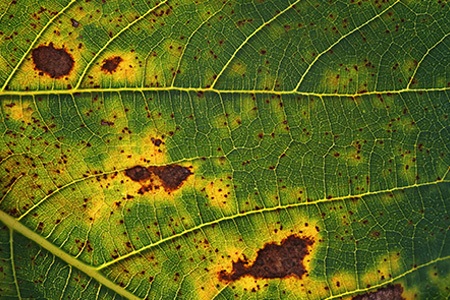
One of the most noticeable signs of overwatering in tomato plants is the appearance of leaf spots and discoloration. Excessive moisture can cause fungal or bacterial infections, which manifest as unsightly blemishes on your plant's foliage.
An example of a common infection caused by overwatering is bacterial speck and bacterial leaf spot. The initial symptoms include small dark spots that appear on the leaves before turning brown and eventually falling off.
Additionally, infected fruits may also develop deformities due to these diseases. Don't use them for making any types of pasta sauce, sliced for sandwiches, to make any types of ketchup, or anything else meant for ingestion.
Foul Odor or Crusty Soil
One of the first warning signs you may notice with an overwatered tomato plant is a foul odor emanating from the soil or even from the plant itself. This unpleasant smell could be indicative of stagnant water that has accumulated in the pot, creating an environment where harmful bacteria and mold can thrive.
Another sign to look out for is crusty soil surrounding your tomato plants. Overwatering often leads to excess moisture in the soil, causing it to become compacted and hard over time.
This crusty surface not only hinders proper root growth but also prevents vital nutrients from penetrating to reach your plant's roots. Additionally, compacted soil reduces air pockets that are essential for healthy root development, thus further stressing your already struggling tomato plant.
How to Save an Overwatered Tomato Plant
To save an overwatered tomato plant, start by shaking off excess dirt and resting the roots on newspaper to dry out, then improve soil aeration and drainage while reducing watering frequency and amount. This kind of work is just another part of backyard farming, so don't guilt yourself over it.
Shake Off Excess Dirt & Rest Roots on Newspaper
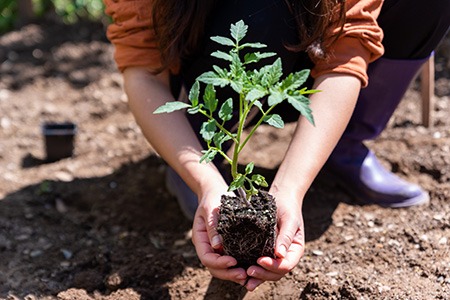
Overwatering can lead to a variety of problems in tomato plants, including root rot and other plant diseases. If your tomato plant is showing signs of overwatering, such as drooping or wilting leaves, leaf spots and discoloration, or crusty soil with a foul odor, it's important to act quickly to save the plant from further damage.
One effective way to do this is by shaking off excess dirt and resting the roots on newspaper. This allows for improved soil aeration and drainage while reducing watering frequency and amount.
In addition to saving an overwatered tomato plant, there are several preventative measures you can take to avoid overwatering altogether. These include improving soil drainage through well-draining soil and mulching around the plant, monitoring soil moisture levels regularly, adjusting watering practices based on weather conditions and seasonality, among others.
Improve Soil Aeration & Drainage
One of the primary ways to prevent overwatering and save an overwatered tomato plant is by improving soil aeration and drainage. Soil that doesn't drain well or has poor aeration can lead to root rot, which can severely damage or kill your tomato plants.
To improve soil aeration, you can add organic matter like compost or vermiculite to the soil. These materials help create space between soil particles, allowing oxygen to reach the roots more easily.
Additionally, increasing soil quality with beneficial microbes and microorganisms will also help with nutrient absorption in your tomato plants’ roots while minimizing various pathogens' growth resulting from waterlogging.
A good practice is starting each growing season with fresh planting material suitable for different kinds of tomatoes grown in pots or gardens for optimal results.
By making these changes when planting your tomatoes instead of reacting only when faced with an overwatered problem later on down the line ensures long term success throughout each growing season.
Reduce the Watering Frequency & Amount
When dealing with an overwatered tomato plant, reducing the watering frequency and amount is crucial. It may seem counterintuitive, but giving your plants too much water can actually harm them and lead to root rot.
Aim to give your tomato plants up to 2 inches (5 cm) of water per week, and reduce watering frequency when the soil feels moist but not puddled.
Overwatering prevention is key for healthy tomato plant care. Ensure that you are planting in well-draining soil and mulching around the base of your plants to help maintain soil moisture levels.
Monitoring soil moisture regularly can also prevent overwatering before it becomes a problem.
Preventative Measures to Avoid Overwatering
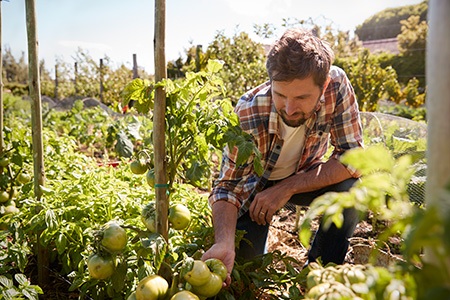
There are ways to make sure too much water for tomato plants doesn't occur. Improve soil drainage by adding organic matter such as compost or vermiculite, and avoid planting in low-lying areas.
Improve Soil Drainage
Improving soil drainage is crucial to preventing overwatering of tomato plants. Without proper drainage, excess water can accumulate in the soil and cause plant roots to rot or suffocate.
One way to improve soil drainage is by adding organic matter such as leaves and compost. This helps increase the number of air pockets in the soil, allowing better absorption of water and nutrients by plant roots.
Another method to improve soil drainage is ensuring pots have enough holes for adequate water flow out of the container.
Water Deeply & Infrequently
When it comes to watering tomato plants, less is often more. Rather than giving your plants small amounts of water every day or two, it's better to water them deeply and infrequently.
To practice this technique, give your tomato plants a good soak once a week rather than smaller doses throughout the week. Make sure the soil has time to dry out completely between watering sessions so that you're not inadvertently overwatering.
Of course, specific watering needs may vary depending on factors like soil type and climate, so be sure to monitor how your plants respond and adjust accordingly.
Mulch Around the Plant & Use Well-Draining Soil
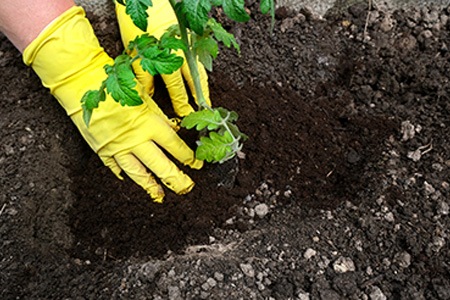
Using mulch around tomato plants is a great way to prevent overwatering. Mulching helps slow down evaporation, which means the soil retains moisture for longer periods of time.
This can be especially helpful during hot summer months or in regions with low rainfall.
It's important to use well-draining soil when growing tomato plants. This type of soil allows excess water to drain away from the roots quickly, preventing waterlogging that can lead to wilting and dying of tomato plants.
Adding organic matter like leaves or compost also helps improve drainage by loosening heavy soil and improving its structure.
Monitor Soil Moisture Levels
To prevent overwatering your tomato plants, it's important to monitor the moisture levels of your soil. You can purchase soil moisture sensors that measure the amount of water in the soil and alert you when it's time to water.
It's essential not only to avoid overwatering but also under-watering, which can stress out your tomato plant. By monitoring the soil moisture levels regularly, you'll be able to adjust your watering frequency and amount according to your plant's needs, ensuring optimal growth and yield.
Adjust Watering Practices
To prevent overwatering tomato plants and maintain their health, it's crucial to adjust your watering practices. Watering too frequently or for excessive durations can lead to waterlogged soil and root rot.
Instead, aim for deep but infrequent watering sessions that allow the soil to dry out partially between each session.
It's important to monitor your plants' appearance regularly as they may wilt not only due to dehydration but also because of excess watering. Check if there are physical signs like crusty soil or an unpleasant odor emanating from wet roots - these are clear indications of overwatering.
Key Takeaways Regarding an Overwatered Tomato Plant
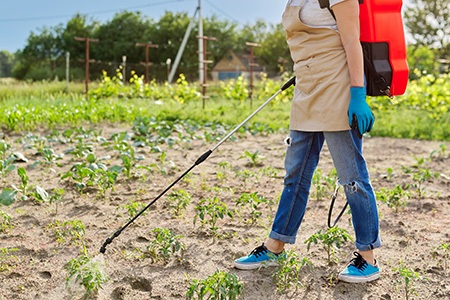
- Overwatered tomato plants can exhibit wilted leaves, yellowing stems, and even root rot.
- Signs of overwatering in tomato plants include drooping or wilting plants, leaf spots and discoloration, foul odor or crusty soil.
- To save an overwatered tomato plant, shake off excess dirt and rest the roots on newspaper to dry out. Improve soil aeration and drainage while reducing watering frequency and amount.
- Preventative measures to avoid overwatering include improving soil drainage by adding organic matter such as compost or vermiculite, watering deeply and infrequently, mulching around the plant with well-draining soil while monitoring soil moisture levels regularly.
That’s the Deal With an Overwatered Tomato Plant
Overwatering your tomato plants can lead to serious health problems and even death. It's important to recognize the signs of overwatering, such as wilted leaves, yellowing foliage, and soggy soil.
By adjusting your watering practices and improving soil drainage, you can help prevent root rot and other fungal infections that commonly affect tomato plants. Remember to monitor your plant's moisture levels regularly and adjust watering accordingly for a healthy harvest of delicious tomatoes.
With these simple tips in mind, anyone can successfully take care of their overwatered tomato plant and avoid common mistakes like our topic of discussion: overwatering.



